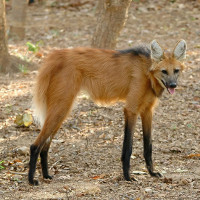 |
Maned wolf |
|
He is a wild animal |
Origin |
South America | |
Translation |
Francis Vandersteen |
| The possession of this animal is not authorized Royal Decree establishing the list of mammals not kept for production purposes that may be kept (M.B. 24.08.2009) |
| The maned wolf (Chrysocyon brachyurus) is a species of carnivore in the Canidae family, native to South America. It is the only representative of its genus : Chrysocyon. Although resembling a wolf or a large fox, the maned wolf is genetically distinct from all other canids. The maned wolf owes its name above all to the presence of a long, abundant black fleece on its neck and shoulders. Its wolf-like appearance, although it can also resemble a long-legged fox, lends credence to this appellation. The tail is relatively short, the ears are erect, and the coat is softer in texture than that of other canids, with no undercoat. The maned wolf's long, slender legs are adapted to its habitat, which consists mainly of tall grass: the cerrado. Despite its appearance, it is not a fast runner. But its large ears enable it to detect the small prey it feeds on. The maned wolf is omnivorous and an opportunistic hunter, attacking prey ranging from small vertebrates to paca. Its most common prey are rabbits, small rodents, birds and armadillos, and more rarely reptiles, insects and even fish. It also eats a lot of fruit (up to half its diet), including the "wolf fruit" (fruit of Solanum lycocarpum, otherwise known as the "tomato-like fruit of Lobeira"). This fruit is said to have anti-parasitic properties against the giant kidney worm, Dioctophyme renate. The maned wolf forages alone, mainly at night. It may also do so during the day, in areas away from humans. Maned wolves generally reproduce from the age of 2, although they can reach sexual maturity in their first year. Females have one litter a year, between June and September. Maned wolves make their homes in dens with sufficient cover. The role of males in raising young in free-living individuals is unknown, but in captivity, they have been known to regurgitate feed. Pairs appear to be monogamous, living in territories of around 30 km2, according to a study of two pairs. |






 English (United Kingdom)
English (United Kingdom)